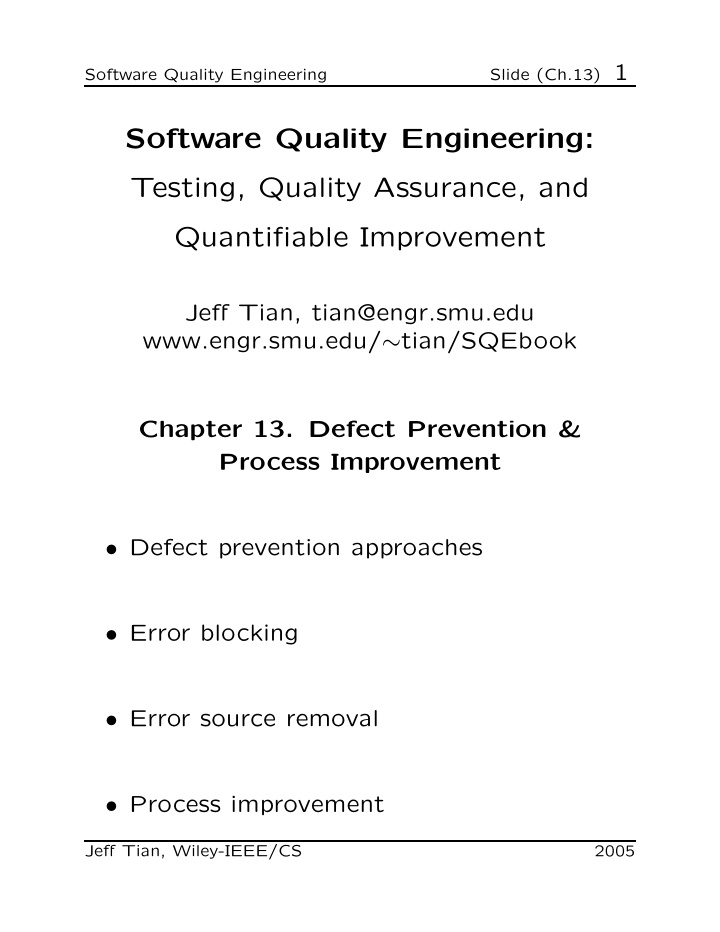



Slide (Ch.13) 1 Software Quality Engineering Software Quality Engineering: Testing, Quality Assurance, and Quantifiable Improvement Jeff Tian, tian@engr.smu.edu www.engr.smu.edu/ ∼ tian/SQEbook Chapter 13. Defect Prevention & Process Improvement • Defect prevention approaches • Error blocking • Error source removal • Process improvement Jeff Tian, Wiley-IEEE/CS 2005
Slide (Ch.13) 2 Software Quality Engineering QA Alternatives • Defect and QA: ⊲ Defect: error/fault/failure. ⊲ Defect prevention/removal/containment. ⊲ Map to major QA activities • Defect prevention (this chapter): – Error source removal & error blocking • Defect removal: Inspection/testing/etc. • Defect containment: Fault tolerance and failure containment (safety assurance). Jeff Tian, Wiley-IEEE/CS 2005
Slide (Ch.13) 3 Software Quality Engineering Generic Ways for Defect Prevention • Error blocking ⊲ Error: missing/incorrect actions ⊲ Direct intervention ⊲ Error blocked ⇒ fault injections prevented (or errors tolerated) ⊲ Rely on technology/tools/etc. • Error source removal ⊲ Root cause analysis ⇒ identify error sources ⊲ Removal through education/training/etc. Jeff Tian, Wiley-IEEE/CS 2005
Slide (Ch.13) 4 Software Quality Engineering Defect Prevention: Why and How? • Major factors in favor of defect prevention: ⊲ Super-linear defect cost ↑ over time – early faults: chain-effect/propagation – difficulty to fix remote (early) faults – in-field problems: cost ↑ significantly ⊲ Other QA techniques for later phases – even inspection after defect injection • Basis for defect prevention: Causal and risk analysis ⊲ Analyze pervasive defects ⊲ Cause identification and fixing ⊲ Risk analysis to focus/zoom-in Jeff Tian, Wiley-IEEE/CS 2005
Slide (Ch.13) 5 Software Quality Engineering Defect Cause and Actions • Types of causal analyses: ⊲ Logical (root cause) analysis by expert for individual defects and defect groups ⊲ Statistical (risk) analysis for large data sets with multiple attributes – Model: predictor variables ⇒ defects – # defects: often as response variable ⊲ Cause(s) identified via either variation • Actions for identified causes: ⊲ Remedial actions for current product ⊲ Preventive actions for future products: – negate causes or pre-conditions Jeff Tian, Wiley-IEEE/CS 2005
Slide (Ch.13) 6 Software Quality Engineering Common Causes/Preventive Actions • Education/training to correct human misconceptions as error sources: ⊲ Product/domain knowledge, ⊲ Development methodology, ⊲ Development process, etc. ⊲ Act to remove error sources ⊲ Cause identification: mostly through root case analysis. • Formal methods, Chapter 15: ⊲ Formal specification: to eliminate imprecision in design/implementation. (error source removal) ⊲ Formally verify fault absence. Jeff Tian, Wiley-IEEE/CS 2005
Slide (Ch.13) 7 Software Quality Engineering Common Causes/Preventive Actions • Technologies/tools/standards/etc.: ⊲ Based on empirical evidence ⊲ Proper selection and consistent usage or enforcement ⊲ More error blocking than error source removal ⊲ Cause identification: mostly statistical • Process improvement: ⊲ Integration of many factors in processes ⊲ Based on empirical evidence or logic ⊲ Define/select/enforce ⊲ Helping both error blocking and error source removal ⊲ Cause identification: often implicit Jeff Tian, Wiley-IEEE/CS 2005
Slide (Ch.13) 8 Software Quality Engineering Education and Training • People: most important factor to quality – e.g., vs. impl. languages (Prechelt, 2000) • Development methodology knowledge: ⊲ Solid CS and SE education ⊲ Methodology/process/tools/etc. • Product/domain knowledge: ⊲ Industry/segment specific knowledge ⊲ Type of products: new vs. legacy etc. – e.g., legacy product characteristics – Table 13.1 (p.227) ⊲ General product environment, etc. • Means of delivery: formal and informal education + on-the-job training. Jeff Tian, Wiley-IEEE/CS 2005
Slide (Ch.13) 9 Software Quality Engineering Other Techniques • Appropriate software technologies: ⊲ Formal methods: Chapter 15. ⊲ Cleanroom: formal verification + statistical testing ⊲ Other technologies: CBSE, COTS, etc. • Appropriate standards/guidelines: ⊲ Mis-understanding/mis-communication ↓ ⊲ Empirical evidence for effectiveness ⊲ Appropriate scope and formality • Effective methodologies: ⊲ As package technologies/std/tools/etc. ⊲ Empirical evidence ⊲ Match to the specific product domain Jeff Tian, Wiley-IEEE/CS 2005
Slide (Ch.13) 10 Software Quality Engineering Tools for Error Blocking • Programming language/environment tools: ⊲ Syntax-directed editor to match pairs. ⊲ Syntax checker/enforcer. ⊲ General tools for coding standards, etc. • Other tools: ⊲ Design/code and version control – examples: CMVC, CVS, etc. ⊲ Tools for indiv. development activities: – testing tools, see Chapter 7 – requirement solicitation tools, – design automation tools, etc. • General tools or tool suites for certain methodologies, e.g., Rational Rose. Jeff Tian, Wiley-IEEE/CS 2005
Slide (Ch.13) 11 Software Quality Engineering Process Improvement • Integration of individual pieces for defect prevention ⇒ process improvement • Selecting appropriate development processes: ⊲ Process characteristics and capability ⊲ Match to specific product environment ⊲ Consideration of culture/experience/etc. • Process definition and customization ⊲ Adapt to specific project environment ⊲ e.g., IBM’s PPA from Waterfall • Process enforcement and ISO/9000: ⊲ “say what you do” ⊲ “do what you say” ⊲ “show me” Jeff Tian, Wiley-IEEE/CS 2005
Slide (Ch.13) 12 Software Quality Engineering Process Maturity for Improvement • SEI/CMM work ⊲ Five maturity levels: ad-hoc, repeatable, defined, managed, optimized ⊲ KPA (key practice areas) for each level ⊲ Expectation: maturity ↑ ⇒ quality ↑ ⊲ Focus on defect prevention ⊲ Recent development: CMMI, P-CMM, SA-CMM, etc. • Other process maturity work ⊲ SPICE (Software Process Improvement and Capability dEtermination) – international effort – assessment, trial, and tech. transfer ⊲ BOOTSTRAP ∈ ESPRIT programme Jeff Tian, Wiley-IEEE/CS 2005
Slide (Ch.13) 13 Software Quality Engineering TAME: Process/Quality Improvement • QIP: Quality Improvement Paradigm ⊲ understand baseline ⊲ intro. process change and assess impact ⊲ package above for infusion • GQM: goals/questions/metrics paradigm ⊲ goal-driven activities ⊲ questions related to goals ⊲ metrics to answer questions • EF: experience factory ⊲ separation of concerns ⊲ EF separate from product organization ⊲ form a feedback/improvement loop Jeff Tian, Wiley-IEEE/CS 2005
Slide (Ch.13) 14 Software Quality Engineering Summary • Key advantages: ⊲ Significant savings if applicable: – avoid downstream problems ⊲ Direct affect important people factor ⊲ Promising tools, methodologies, etc. ⊲ Process improvement: long-lasting and wide-impact • Key limitations: ⊲ Known causes of pervasive problems ⊲ Difficulties analyzing complex problems ⊲ Difficulties with changing environment ⊲ Hard to automate ⊲ Process quality � = product quality • Comparison to other QA: Chapter 17. Jeff Tian, Wiley-IEEE/CS 2005
Recommend
More recommend